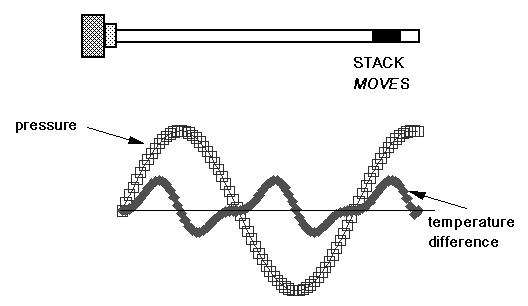Experiment of The Month
Acoustic Heat Pump
The MU Physics Department does not claim to have invented these labs. Actually, the origin of these labs is currently unknown to us. Our labs do not have written instructions. In keeping with this spirit, the description given here will be brief and general. The intent is that each performance of the lab will be unique; in each nature will reveal a slightly different face to the observer
This month's laboratory exercise is replaced with an experiment developed by Christopher French for his Senior Seminar project. The device which he built uses an acoustic standing wave to pump heat a distance of approximately 5 cm, generating a temperature difference of about 10 degrees Celsius. A sketch of the apparatus is shown below, along with graphs indicating the pressure variation along the resonance tube for several times within a cycle. (The period of the sound wave is T.) The tube, 1.7m long and about .03m in diameter, is open at the speaker end, and closed at the other end. It is shown the third resonance mode, with the tube length equal to 3/2 of a wavelength. (Frequency about 260 Hz)
If we assume that the gas is adiabatic, then the density and the temperature of the gas plot the same as the pressure above. If we insert an object (at room temperature) at location A, then when the pressure, temperature, and density are high, the object will be warmed by the hotter gas. When the pressure, temperature, and density reach their minimum (1/2 period later) heat will flow back from the object to the gas, but not as much.
The reason for the difference is that the density (and temperature) of the gas are reduced when the pressure is lowered, and thus the heat capacity (and the thermal conductivity) are lower. The density is lowered because some gas has moved from the high pressure region. If this gas arrives at point B (for example), it is cooler than ordinary, because it has given up heat to the object at A. It absorbs heat from the local surroundings.
The net effect is that the standing sound wave drives a heat flow from B to A. If point A is thermally anchored at room temperature, point B is cooled, and can be used to cool a refrigerator. A more complete description of the physics is given in a Physics Today article: Thermoacoustic Engines and Refrigerators, by Gregory W. Swift, Physics Today July 1995. A synopsis of this article is available on line at web address:
In practice, instead of having just two locations, A and B, a "stack" of locations is used between A and B. Heat is pumped along the stack, in the direction from B towards A. Following suggestions by Steven Garrett, Chris used a bundle of the small (about 1 mm diameter, 10 cm length) plastic straws used in cafeterias as coffee stirrers. The straws lie parallel to the axis of the resonance tube. The straws allowed the air to pass through during its oscillation, but made enough contact to exchange heat with the air. A pair of thermocouples was connected to a pair of metal screens, one at each end of the stack of straws (e.g. at points A and B in the first figure).
When the 8 Ohm loudspeaker was driven with a signal of 10 Volt amplitude, the stack developed a temperature difference of about 10 degrees Celsius, with the end closer to the pressure extreme always being warmer. When the position of the stack was changed by moving it along the length of the resonance tube, this temperature difference varied as sketched in the figure below. (The horizontal axis represents the position of the middle of the stack of straws.)
The sketch of temperature difference was made by multiplying the displacement amplitude by the cube of the pressure amplitude. This is consistent with a refrigerator whose efficiency is proportional to the product of three terms: The work done on the gas; the density of the gas; and the thermal conductivity of the gas.
Thermoacoustic refrigerators have not yet been perfected. Parameters which may be adjusted to optimize performance include the thermal conductivity and heat capacity of the gas, the period of the sound (which determines how long the gas has to transfer heat at each end of the stack), the displacement amplitude of the standing wave, the length of the stack, the geometry of the stack, and the material(s) used in the stack. The fact that this device could have been invented 60 years ago, but was not, reminds us that amazing things lie just below the surface of the ordinary world.
-
Contact Information
Contact Number: 717-871-4297
Email: physics@millersville.edu

